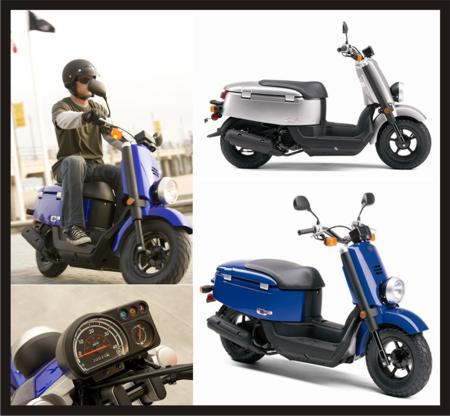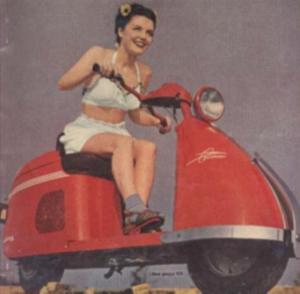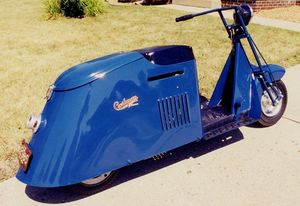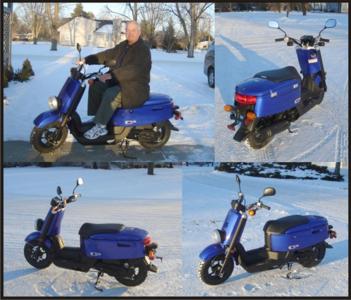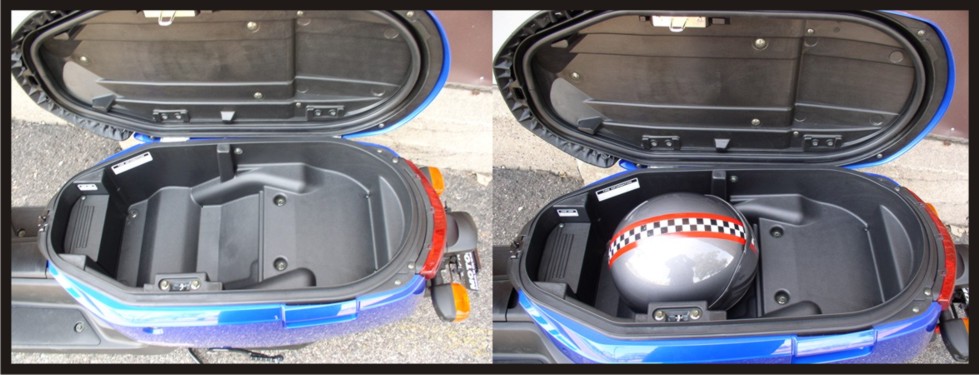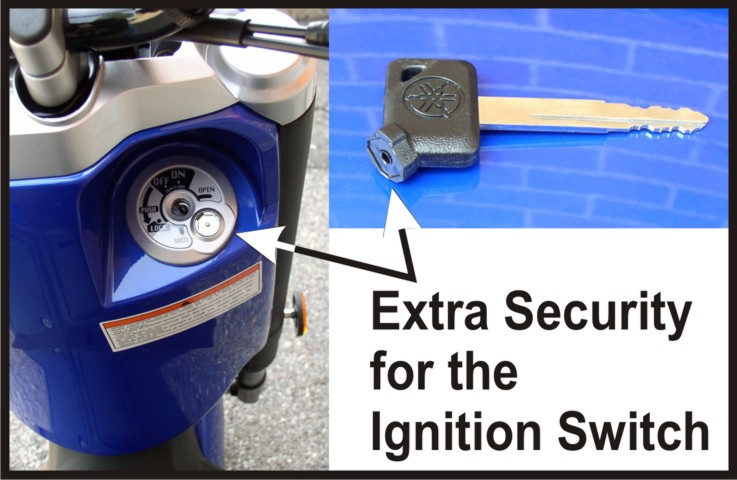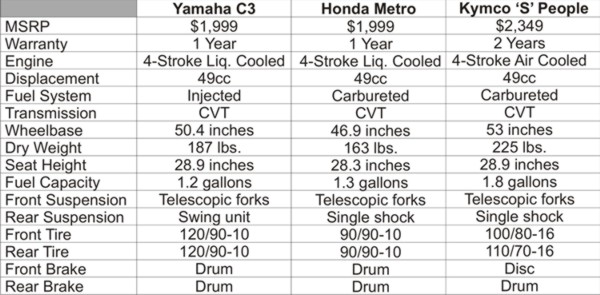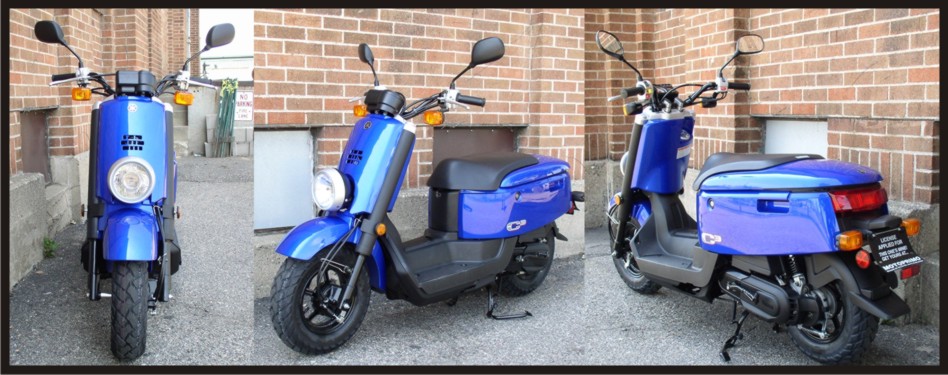Is it just me? Or does this look a little like the old Cushman (or Salsbury, or…)scooter?
Yeah, it’s probably just me. I think it’s principally the shape of the body and the seating that brought the venerable Cushman to mind. Yamaha’s boxy design (C3…. get it?) certainly looks functional. Yamaha says that there is nine gallons of storage capacity. The C3 is powered by a fuel injected four-stroke 49cc motor and has a friendly seat height of 29 inches. Having about a 30 inch inseam myself, I consider this to be a normal seat height, it’s the rest of you freakishly tall people with your 34 inch inseams that are the weirdoes. Price is $1,999.
June 2007 – I just completed my short-term test of the new Yamaha C3 (scroll down to read the review) and it’s every bit as nice as one would expect from Yamaha. The fit and finish is excellent.
Here’s the link to the Yamaha C3 webpage:
http://www.yamaha-motor.com/sport/products/modelhome/529/0/home.aspx
Yamaha C3 Scooter Delivered to a JustGottaScoot Member
Motor City Powersports delivered the above C3 to Lysle in early February. According to Lysle, “…just one ride around the block tells me I am really going to like this.” Lysle said the power feels close to his 2000 Zuma, but that the C3 is much, much quieter.
Lysle is an interesting guy – counting mopeds, small motorcycles and motorscooters, this Yahama C3 is his 23rd powered two-wheeled conveyance in 52 years. with any luck, Lysle will let us know more about his riding impressions…. after the snow melts.
Review of the Yamaha C3
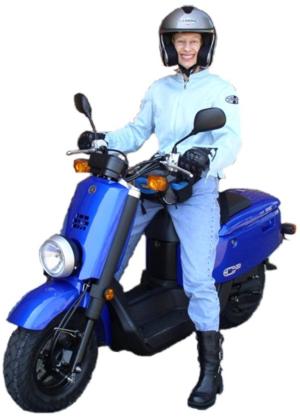
The Yamaha C3 is a 50cc (well, 49cc really) four-stroke scooter and, depending on where you live, doesn’t require a motorcycle endorsement to operate. Even though a lot of states call the license plate a “moped”, I’m not going to use that particular ‘m’-word in describing the Yamaha C3.
Thanks to MotoPrimo and Jonathan Wheelock (the sales manager at MotoPrimo Central), I was given a Yamaha C3 to play with for a day. This gave me, and my wife Beverly, an opportunity to put a C3 through it’s paces. I did not do a formal fuel mileage test, but based on about 50 miles of riding, it looks like fuel economy will be in the 100 – 115 miles per gallon range. That’s not my fat fingers miss-typing…. fuel economy of over 100 MPG. The Yamaha C3 is a fuel injected four-stroke and is pretty light (187 pounds) so I believe that 100+ MPG is a realistic expectation for this scooter. I also believe that silly fun is a realistic expectation.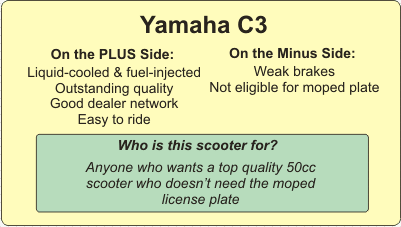
Features and Riding Impressions
The Yamaha C3 comes equipped with the basics that one would expect from Yamaha – good lighting, a decent though minimalist dash and excellent build quality.
There’s a large speedometer with an integrated odometer, a fuel gauge and some warning lights. The controls layout is what most of us expect on a modern twist-and-go scooter: rear brake, high and low headlight beams, turn signal switch and horn on the left, engine stop switch and starter along with front brake and throttle on the right. The fuel filler is down on the center tunnel and was easy to access and to fill with no spillage.
The entire seat platform is hinged on the left side and lifts to expose the underseat storage. This are will hold up to nine gallons of stuff. It’s shallower toward the rear, but as you can see in the above image, my “mellon-head” 3/4 helmet fit easily in the front part. Considering the available storage on most other scooters in this class, the Yamaha C3 ranks as excellent for space.
There is also a cool extra security feature on the Yamaha C3 – the key has a fitting that goes into a receiver on the ignition switch that closes the key access for the switch. A while back, we had a theft attempt on our Genuine Blur and the would-be thief ruined the switch trying to pop the ignition. Hopefully, this additional feature will help prevent that from happening to Yamaha C3 owners.
Riding the Yamaha C3 is… how shall I put this… incredibly easy. It starts right up, settles very quickly into a smooth idle and doesn’t have an even remotely intimidating element to it. My wife Beverly said she thought this would be the best scooter out there for someone to learn on if they were a little skittish of the whole scooter scene. The engine is responsive, but not at all threatening even to someone who has never been on a scooter. The handling is stable and friendly requiring minimal effort on the part of the driver. The brakes (drums on both ends) are progressive and work well.
The Yamaha C3 is a one-person ride, not really any provision for a passenger.
By no stretch of the imagination could the Yamaha C3 be considered “fast” or even “quick.” With my (hefty) 200+ pounds on it, it took some time to build up speed. That being said, my wife thought that the smooth, even and mild acceleration was one of the strong points that would appeal to new riders. The C3 we tested did get up to 40 MPH. I didn’t have my GPS unit with me for the review, but based on a measured mile and my watch, the speedometer is pretty accurate for a scooter reading only about 5% optimistic. I did not have an opportunity to run the Yamaha C3 side-by-side with a Honda Metropolitan or Kymco 4-stroke 50cc, but based on my impressions from the Metros I have ridden, the C3 feels a touch faster.
The Competition
There is a great deal of competition in the lower end of the scooter market. For the comparison chart, I chose the Honda Metro and the Kymco People 50.
Frankly, I consider the Honda to be the main competition for the C3. The Kymco People 50 in 4-stroke is a much bigger scooter (look at the difference in tire size). There are LOTs of other scooters that many people would list as competitors for the Yamaha C3, but most of them are not even close to the C3 in quality or dealer support. Yes, I’m talking about the plethora of low-cost 50cc scooters available online or at “non-dealers” like automotive parts stores or even mobile phone and pager stores. In my opinion it’s just not realistic to consider a $700 – $1,200 scooter as real competition for a $1,999 C3. I have seen more people than I care to mention purchase these cheap scooters only to run into serious mechanical issues and no support. Let me put it this way: if there really was a great quality $1,000 scooter out there don’t you think every legitimate scooter dealer in existence would RUSH to carry them?
People who buy scooters like the Yamaha C3 or the Honda Metro (and there are lots of them) know that quality, support and longevity cost a certain amount.
Fit and Finish
It’s a Yamaha – great paint, everything fits and is tight, quality throughout. I just don’t know what else to say.
Value
I don’t think it’s possible to assess “value” without some qualifications. If you are looking for a small, friendly, cheap to ride scooter the Yamaha C3 is a great value. Of course there are some compromises to get a sub-$2,000 new scooter out of Yamaha – the drum brakes for example. If you are looking for performance and high end features, I don’t think you are really considering a Yamaha C3, so for you, it wouldn’t be a good value. In my opinion, “value” comes down to what best suits your needs and desires at a price you can afford. If the Yamaha C3 fits what you’re after, it’s a great value. My own opinion is that between the Yamaha C3 and the Honda Metro, I would take the C3 – I like the look better (it’s the light just above the front fender – what can I say).
Conclusion
EASY to ride, fun (within limits), good storage, fabulous fuel economy, outstanding build quality… if the look appeals to you (as it does to me) – go for it!
David L. Harrington June, 2007

